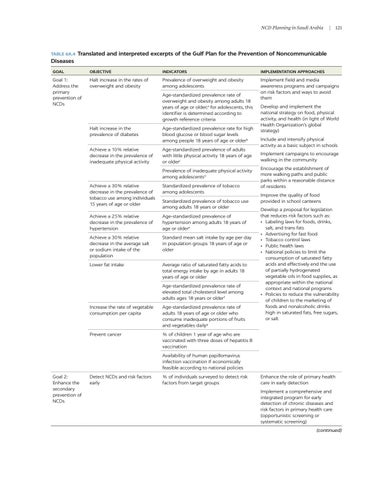NCD Planning in Saudi Arabia | 121
TABLE 6A.4 Translated
and interpreted excerpts of the Gulf Plan for the Prevention of Noncommunicable
Diseases GOAL
OBJECTIVE
INDICATORS
IMPLEMENTATION APPROACHES
Goal 1: Address the primary prevention of NCDs
Halt increase in the rates of overweight and obesity
Prevalence of overweight and obesity among adolescents
Implement field and media awareness programs and campaigns on risk factors and ways to avoid them
Age-standardized prevalence rate of overweight and obesity among adults 18 years of age or older;a for adolescents, this identifier is determined according to growth reference criteria Halt increase in the prevalence of diabetes
Age-standardized prevalence rate for high blood glucose or blood sugar levels among people 18 years of age or olderb
Achieve a 10% relative decrease in the prevalence of inadequate physical activity
Age-standardized prevalence of adults with little physical activity 18 years of age or olderc Prevalence of inadequate physical activity among adolescentsd
Achieve a 30% relative decrease in the prevalence of tobacco use among individuals 15 years of age or older
Standardized prevalence of tobacco among adolescents
Achieve a 25% relative decrease in the prevalence of hypertension
Age-standardized prevalence of hypertension among adults 18 years of age or oldere
Achieve a 30% relative decrease in the average salt or sodium intake of the population
Standard mean salt intake by age per day in population groups 18 years of age or older
Lower fat intake
Average ratio of saturated fatty acids to total energy intake by age in adults 18 years of age or older
Standardized prevalence of tobacco use among adults 18 years or older
Age-standardized prevalence rate of elevated total cholesterol level among adults ages 18 years or older f Increase the rate of vegetable consumption per capita
Age-standardized prevalence rate of adults 18 years of age or older who consume inadequate portions of fruits and vegetables dailyg
Prevent cancer
% of children 1 year of age who are vaccinated with three doses of hepatitis B vaccination
Develop and implement the national strategy on food, physical activity, and health (in light of World Health Organization’s global strategy) Include and intensify physical activity as a basic subject in schools Implement campaigns to encourage walking in the community Encourage the establishment of more walking paths and public parks within a reasonable distance of residents Improve the quality of food provided in school canteens Develop a proposal for legislation that reduces risk factors such as: • Labeling laws for foods, drinks, salt, and trans fats • Advertising for fast food • Tobacco control laws • Public health laws • National policies to limit the consumption of saturated fatty acids and effectively end the use of partially hydrogenated vegetable oils in food supplies, as appropriate within the national context and national programs • Policies to reduce the vulnerability of children to the marketing of foods and nonalcoholic drinks high in saturated fats, free sugars, or salt
Availability of human papillomavirus infection vaccination if economically feasible according to national policies Goal 2: Enhance the secondary prevention of NCDs
Detect NCDs and risk factors early
% of individuals surveyed to detect risk factors from target groups
Enhance the role of primary health care in early detection Implement a comprehensive and integrated program for early detection of chronic diseases and risk factors in primary health care (opportunistic screening or systematic screening) (continued)

